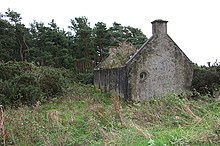But and ben

But and ben (or butt and ben) is an architectural style for a simple building, usually applied to a residence. The etymology is from the Scots term for a two-roomed cottage.[1] The term describes a basic design of "outer room" conjoined with "inner room" as a residential building plan; the outer room, used as an antechamber or kitchen, is the but, while the inner room is the ben.[2] The word but, here, comes from Early Scots/Middle English "bouten" "outside", and ben from ES/ME "binnen", "inside".
See also
References
- C. Michael Hogan, Knossos fieldnotes, Modern Antiquarian (2007)
- Ernest Ingersoll (1906) The Wit of the Wild, Published by Dodd, Mead and company, 294 pages
Line notes
- ^ Robinson, Mairi (1985). The Concise Scots Dictionary. Aberdeen: Aberdeen University Press. p. 75. ISBN 0-08-028492-2.
- ^ Jamieson, John (1808). An Etymological Dictionary of the Scottish Language: Illustrating the Words in Their Different Significations, by Examples from Ancient and Modern Writers; Shewing Their Affinity to Those of Other Languages, and Especially the Northern; Explaining Many Terms, Which, Though Now Obsolete in England. Creech, Constable, and Blackwood. p. 46.
